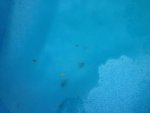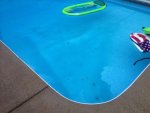Based on what you describe it may not be algae. You say it isn't green clumpy, isn't yellow/mustard dust/powder, isn't black stuck to pool surfaces, but is instead more white. That sounds like it might be more of a fungus such as white water mold. On the other hand, you've put so many products into your pool water that you could be having chemical reactions coagulating some of those chemicals. Let's review some of what you put in:
Coral Seas Yellow Out -- this is a combination of EDTA which is a metal sequestrant but can also inhibit some algae (see
this EPA report) and ammonium sulfate which is basically ammonia and will quickly react with chlorine to produce monochloramine. It is the monochloramine that works around a high CYA level to kill algae while the EDTA continues to inhibit and kill it over a longer period of time. EDTA breaks down from chlorine so creates a chlorine demand.
Algaecide 60 is probably Polyquat which is a cationic (positively charged) polymeric algaecide.
Omni Algae Terminator is copper sulfate pentahydrate so copper ions that kill algae, but can also stain plaster pools and make blond hair greenish.
Algae Kill Granular is probably Trichlor granular.
N Jonas Hydro Floc may be polyaluminum chloride which is a positively charged flocculant
So part of the problem may be that you don't actually have algae growing at this point but that you are precipitating chemicals basically floc'ing your EDTA. Both alum floc and Polyquat are positively charged and may be attracted to and precipitate negatively charged salt of EDTA. You've basically created a precipitated/coagulated mess of a chemical soup.
I would not try and resolve this through SLAMing (even though you already got started with it) but rather by physically removing this product from the pool by trying to physically remove it via skimmer socks, filtration (either vacuum to waste, if you can, or brushing and filtering if you cannot), and even a slime bag. There is probably a pH that will optimize coagulating this stuff, but I'm not sure what it would be. You should probably try removing most of it first, then see what happens if the pH is lowered closer to 7.0 and if more stuff shows up, remove it, then raise the pH closer to 8.0 (but careful because you've got that copper in their, but at least your pool is vinyl) and see if more stuff shows up and remove it. After you get most of this chemical soup removed, then you can SLAM to get rid of any dissolved remnants, particularly of EDTA which will get oxidized by chlorine.
While you are doing all of this chemical clean-up, you do want to maintain the proper FC/CYA level and you may find that you have a higher than normal chlorine demand so just make sure you have at least 5 ppm FC for your presumed 60 ppm CYA level. If after getting your test kit the CYA level is different, then adjust accordingly. Since you've already started a SLAM, you could continue, but I wouldn't have started there.
Chlorine does NOT clear up every mess. It is not a panacea and sometimes you have to physically remove chemicals from the water, especially those that won't react with chlorine (such as alum floc).
In the future, do not let anyone convince you that you have algae if it is not either green and clumpy or green cloudy water OR black slow growing on surfaces (and smears dark green on white paper) OR is yellow or mustard in color and dust-like that sweeps into a cloud and prefers the shady side of the pool. If it's white, then unless it's dead algae, it's not algae. Alage (and cyanobactria) have chlorophyll and use sunlight to grow so they are always some form of color in the yellow, mustard, green, black range. You won't find them blue or magenta or a combination that looks white.





 This post very likely will make you mad and could easily be construed as offensive. It is not my intent to be offensive but rather to help you get a grip on some basic science and let us help you get your pool crystal clear and clean. We can do that if you will help us by following the advice you get here and ignoring ALL other advice.
This post very likely will make you mad and could easily be construed as offensive. It is not my intent to be offensive but rather to help you get a grip on some basic science and let us help you get your pool crystal clear and clean. We can do that if you will help us by following the advice you get here and ignoring ALL other advice.